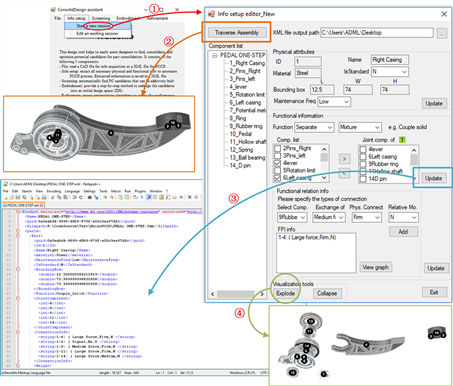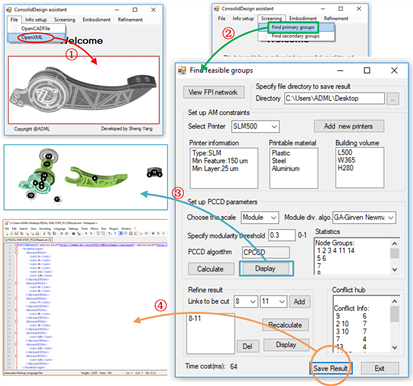Project Description :
Additive manufacturing (AM) has extremely expanded and refreshed the way how product is designed and made. Part consolidation is one of these new opportunities. Against the conventional philosophy of segmenting a complex design into multiple simple parts and then rejoined with welding or bolts, part consolidation facilitates "complexity for free" mindset and helps designers be focused on "design for function" rather than "design for manufacture and assembly". The main challenges include:
- Part Consolidation Candidacy Detection (PCCD)
- Fusion of parts with AM characteristics

Introduction of ConsolidDesign
The ConsolidDesign Assistant is a developed plugin for Rhinoceros in support of part consolidation redesign.
The main program is written in C# language. User interface (UI) and data access are derived from the built-in
classes and methods from Microsoft .NET framework. Extracted data from the design tool is saved and read by
following the Extensible Markup Language (XML) schema. For geometric and material information of the CAD
model, it is accessed and manipulated by RhinoCommon.
The tool has four modules:
- Info setup: This module acquires user inputs including part information such as functions, material, maintenance frequency, and part-part adjacency, interaction strength, and relative motion, etc. The extracted information are saved in an XML file.
- Screening: This module reloads the xml file generated in "info setup" module, and provides the main function
of automatically grouping part candidates with user-defined AM machine constraints. The feasible parts are colored in accordance with the group.
- Embodiment: This module provides a guided design method to instruct designers of how to fusion the sorted parts into
designated one piece(s) without assembly interfaces. Within the module, it consists of three main concepts: function interface, function volume, and initial design space. The general idea is to identify
the real unchangeable design parameters and modify the rest.
- Refinement: With the inputs of the initial design space of the embodiment module, design space and non-design space are predefined.
Then different optimization techniques can be applied such as lattice or topology optimization.This module is included only to demonstrate
its seamless integration potential with downstream design activities.
All related work is reported in the following publications.
[1] Yang, S., Tang, Y., & Zhao, Y. F. (2015). A new part consolidation method to embrace the design freedom of additive manufacturing.
Journal of Manufacturing Processes, 20, 444-449.
Download
[2] Yang, S., Santoro, F., & Zhao, Y. F. (2018). Towards a numerical approach of finding candidates for additive manufacturing-enabled part consolidation.
Journal of mechanical design, 140(4), 041701.
Download
[3] Yang, S., & Zhao, Y. F. (2018). Additive manufacturing-enabled part count reduction: a lifecycle perspective.
Journal of mechanical design, 140(3), 031702.
Download
[4] Yang, S., Santoro, F., Sulthan, M. A., & Zhao, Y. F. (2019). A numerical-based part consolidation candidate detection approach with modularization considerations.
Research in Engineering Design, 30(1), 63-83.
Download



